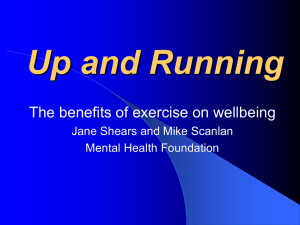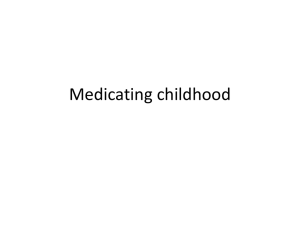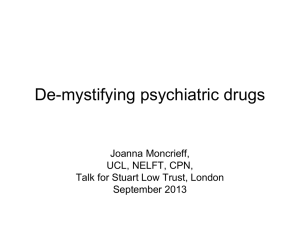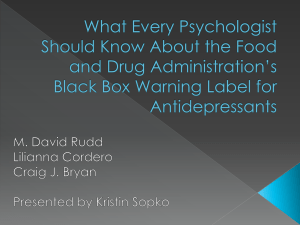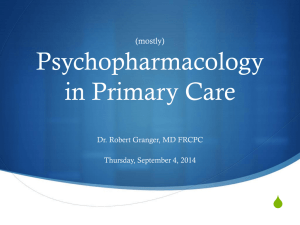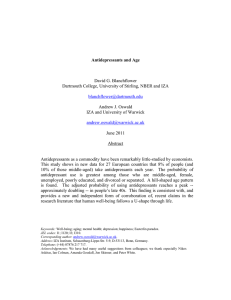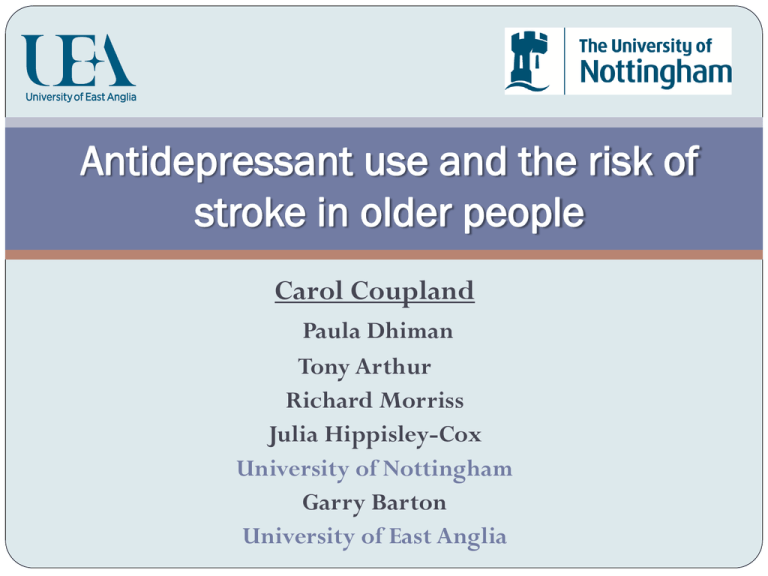
Antidepressant use and the risk of
stroke in older people
Carol Coupland
Paula Dhiman
Tony Arthur
Richard Morriss
Julia Hippisley-Cox
University of Nottingham
Garry Barton
University of East Anglia
Depression in older people
Depression is a common condition
in older people (around 15%)
It is associated with increased rates
of morbidity and mortality
It is mainly treated in primary care,
frequently with antidepressants
2
Adverse effects of antidepressants
Around 14 million prescriptions for antidepressants
were issued to people aged 60+ in 2007, an increase of
10.1% compared with 2006 and 79.0% compared with
2000
Little is known about adverse effects of antidepressants
in older people
Some studies have shown that antidepressants may
increase risk of stroke
3
Study design
Cohort study carried out using QResearch primary care
database.
Patients were included if:
they had a recorded diagnosis of depression
the diagnosis was made at the age of 65 or over
the diagnosis was between 1/1/1996 to 31/12/2007
they were no more than 100 years at diagnosis
the diagnosis occurred at least 12 months after registration
with a study practice.
4
Exposures
Antidepressant prescriptions categorised as:
Tricyclic and related antidepressants (TCAs)
Selective Serotonin Reuptake Inhibitors (SSRIs)
Monoamine oxidase inhibitors (MAOIs)
Other antidepressants
Combined treatment
Antidepressants also categorised by dose, duration and
individual drugs.
5
Analysis
Outcome was diagnosis of stroke or transient ischaemic attack (TIA)
during follow-up to 31/12/2008.
Cox’s proportional hazards model used to calculate unadjusted and
adjusted hazards ratios for antidepressant use (time varying)
Adjusted for:
6
• age , sex, study year, previous diagnosis of depression, severity of
depression (mild, moderate or severe), smoking status
• deprivation, based on Townsend deprivation score
• comorbidities (ischaemic heart disease, diabetes, hypertension, stroke,
cancer, dementia, epilepsy, Parkinson’s disease, hypothyroidism, obsessivecompulsive disorder)
• use of other drugs (statins, NSAIDS, anti-psychotics, lithium, aspirin,
antihypertensive drugs, anticonvulsants, hypnotics/anxiolytics).
Results
There were 60,464 patients in the study cohort
54,038 (89.0%) received at least one prescription for an
antidepressant drug during follow-up
There were 1,398,359 prescriptions for antidepressants
31.6% for TCAs, 54.7% for SSRIs, 0.2% for MAOIs,
and 13.5% for the class of other antidepressants.
The median duration of treatment with antidepressants
during follow-up was 364 days (IQR 91, 1029).
7
Stroke/TIA outcome
During follow-up 5369 (9.9%) of patients had an
incident stroke/TIA, during 265,410 person-years of
follow-up
Crude incidence rate was 202 per 10,000 person-years
(95% CI (197 to 208).
8
Adjusted hazard ratios and 95 % CI for stroke
0.80
1.00
1.20
1.40
1.60
1.80
2.00
Hazard ratios for antidepressant class
TCAs
SSRIs
Other
combined
antidepressant class
9
*note: hazard ratios compared to periods of non-use of antidepressants
Hazard ratios for antidepressant dose
antidepressant dose
10
*note: hazard ratios compared to periods of non-use of antidepressants
D
DD
>1
.0
Ot
he
rs
1D
DD
0.5
Ot
he
rs
<=
0.5
D
DD
D
Ot
he
rs
DD
SS
RI
s>
1.0
D
D
DD
SS
RI
s0
.51
DD
DD
s>
1.0
D
TC
A
SS
RI
s<
=0
.5
D
DD
TC
As
0.5
-1
TC
As
<=
0.5
DD
D
0.80 1.00 1.20 1.40 1.60 1.80 2.00
Adjusted hazard ratios and 95 % CI for stroke
Hazard ratios for antidepressant timing
antidepressant timing
11
*note: hazard ratios compared to periods of non-use of antidepressants
Ot
he
r:8
5+
da
ys
ay
s
Ot
he
r: 2
9-8
4d
da
ys
Ot
he
r: 1
-28
RI
s:8
5+
da
ys
SS
ay
s
29
-84
d
SS
RI
s:
da
ys
1-2
8
RI
s:
SS
s:8
5+
da
ys
TC
A
ay
s
s:
29
-84
d
TC
A
TC
A
s:
1-2
8
da
ys
0.0
0.5
1.0
1.5
2.0
2.5
3.0
Adjusted hazard ratios and 95 % CI for stroke
12
(TC
A)
(TC
A)
Lo
fep
ra m
ine
(TC
A)
Tra
zo
do
ne
(TC
A)
Cit
alo
pra
m
(S
SR
Es
I)
cit
alo
pra
m
(S
SR
I)
Flu
ox
eti
ne
(S
SR
I)
Pa
rox
eti
ne
(S
SR
I)
Se
rtra
lin
e(
SS
RI
Mi
)
rta
za
pin
e(
oth
er)
Ve
nla
fax
ine
(ot
he
r)
Do
su
lep
in
Am
itri
pty
lin
e
0.80 1.00 1.20 1.40 1.60 1.80 2.00
Hazard ratios for individual drugs
Adjusted hazard ratios and 95 % CI for stroke
antidepressant drug
*note: hazard ratios compared to periods of non-use of antidepressants
Excess risks
For each 10,000 patients treated with:
SSRIs - 38 additional people would have a stroke in one
year compared with no treatment
other antidepressants - 81 additional people would have
a stroke in one year compared with no treatment
13
Summary of findings
Stroke risk is significantly increased for SSRIs and the
class of other antidepressant drugs, compared with
TCAs and periods of no use of antidepressants.
Little evidence of a dose response relationship.
Stroke rates were highest in the first 28 days of starting
an SSRI antidepressant
Among individual antidepressant drugs the highest
hazard ratios were for Venlafaxine Hydrochloride and
Mirtazapine.
14
Strengths
Large study in a primary care setting
Accounted for many confounding variables
One of few studies to investigate effects of individual
drugs
Detailed information on antidepressants prescribed
15
Limitations
Difficult to distinguish effects of antidepressant
treatment from effects of depression itself
May be channelling bias - different drugs prescribed
according to various patient characteristics
Residual confounding – some stroke risk factors may not
be recorded in GP records
16
Conclusions
SSRIs and drugs in the class of other antidepressants
may have increased risks of stroke compared with TCAs.
A careful evaluation of benefits and adverse outcomes is
needed when prescribing antidepressants to older people
which should include consideration of TCAs
17
Acknowledgements
This project is funded by the NHS R&D Programme Health
Technology Assessment Programme (project number
06/42/01) and will be published in full in the Health
Technology Assessment journal. See the HTA programme
website for further project information.
We thank the contribution of practices and patients who
provide data to QResearch
18
Department of Health Disclaimer
The views and opinions expressed are those of the research team
and do not necessarily reflect those of the Department of Health.

